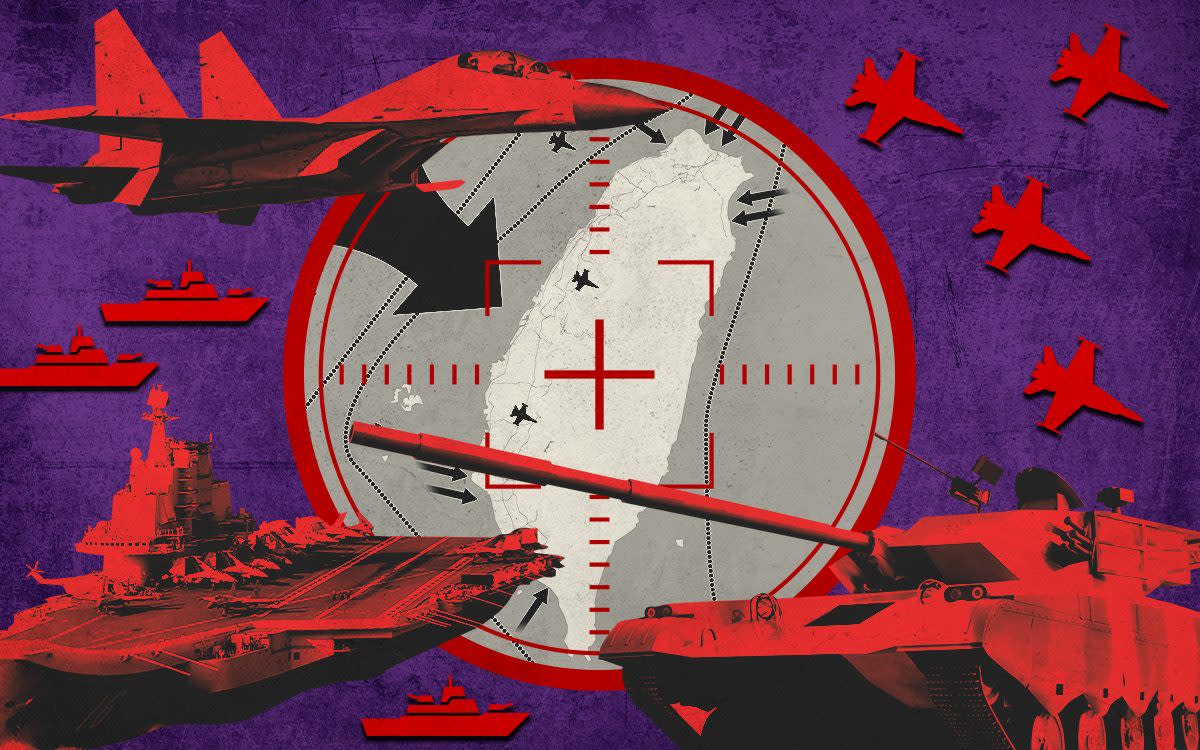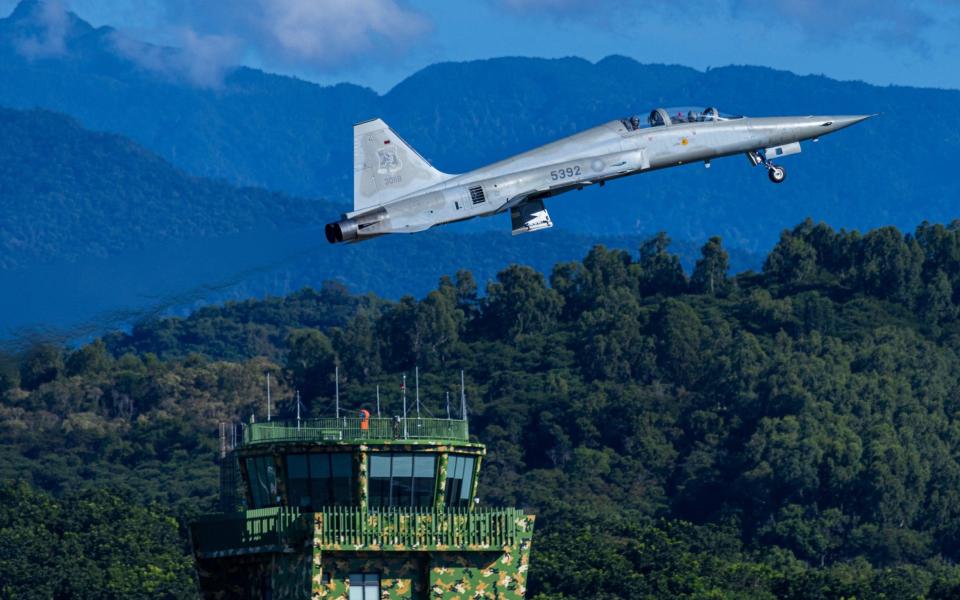Four ways China could take Taiwan as military tensions boil over

When China decides to take Taiwan by force, it will aim to do so via a lightning-fast 48-hour offensive so that the West does not have time to respond, diplomatic sources have told The Telegraph.
Beijing has repeatedly threatened to take the self-ruled island, which it claims as its own.
Since Thursday China has been holding unprecedented war games, encircling the island to show its fury after Nancy Pelosi, a senior Democrat and third in line to the US presidency, became the most senior visitor to the territory in 25 years. The drills are set to end on Sunday.
Taiwan’s unification with the mainland is part of President Xi Jinping’s strategy to “revive” the Chinese nation by 2050, and Beijing was previously thought to be preparing for an “armed reunification” at some point in the next five to 10 years.
But now a number of Western governments are working on the assumption that a military offensive will come much sooner, with Mr Xi having learned lessons from Russia’s failures in Ukraine.
Beijing ‘learned lessons from Ukraine invasion’
The Telegraph understands that Beijing has reviewed Moscow’s invasion and the West’s response to see what lessons should be learned for China’s armed forces.
Beijing has reportedly deduced that it took at least two days for Western leaders to properly respond when President Vladimir Putin launched his brutal assault on Ukraine on Feb 24 - and that this is the crucial window of time when irreversible gains can be made.
By failing to take Kyiv and topple Volodymyr Zelensky’s government in the first 48 hours of the war, Mr Xi believes the Russians left the door wide open for significant Western support, according to diplomatic sources.

Avoiding making the same mistake with Taiwan will be key to avoiding a long, drawn-out war that could backfire on the Chinese Communist Party, Beijing is reported to have concluded.
Once Taiwan, the world’s biggest microchip manufacturer, falls to China, Western hawks have warned allies the territory will be gone forever.
It comes as Beijing on Saturday continued to hold a third day of major military drills.
“Multiple batches” of Chinese planes and ships were dispatched in exercises the Taiwanese defence ministry described as “conducting a simulation of an attack on Taiwan’s main island”.
Attack could come as soon as 2023
Despite all the posturing, however, it is unlikely this current crisis will spiral into war anytime soon.
Any potential military action would face the “realistic possibility of war with the US”, according to Sidharth Kaushal of think tank Rusi, adding that “the PLA is still an evolving force”.
Despite reportedly being the world’s biggest army, the Chinese People’s Liberation Army (PLA) is untested in combat and failure could fatally undermine Mr Xi’s hold on power ahead of a key party congress at which he is expected to be granted an unprecedented third term.
“It’s probably unachievable right now. There are some substantial risks for China,” Mr Kaushal added.
But China has made no secret of the fact that it believes Taiwan is part of its territory and will use force to bring the island back under its control, if necessary.


The two biggest unanswered questions are when, and how.
Taiwan has warned in the past that any attack could come as early as 2023. Other security analysts predict later, but most think it will be attempted at some point.
In terms of how, the events of this week have made things a little clearer.
China’s unprecedented war games have featured missiles fired into the waters around Taiwan as well as reportedly over the island itself, along with a naval blockade and sorties of fighter jets entering the territory’s air space. Earlier in the week the PLA practised amphibious landings on a beach facing Taiwan.
Some or all of these things could feature in any future military operation.
Beijing is instead likely to stage a progressive and incremental build up of forces, with each new posture falling just short of warranting a military response from the West that could lead to the outbreak of a full-blown war.
As it progresses up the escalation ladder, Beijing’s aim would be to squeeze Taiwan until its only option left is cooperation, as if in the coils of a snake. Or the tail of a dragon.
There are broadly four possible scenarios that might develop in sequence or tandem:
1. China blockades Taiwan
Extended military exercises could be used to wear down Taiwan financially, economically and operationally - it would exhaust the Taiwanese armed forces to be held on high-readiness for long periods of time.
They would also enable China to deploy military assets in the best possible positions to be able to launch attacks rapidly.
Using exercises such as those under way this week as a pretext, a fully enforced customs and no-fly zone could easily be set up to isolate Taiwan from outside assistance.
The seven zones in which Chinese forces are currently exercising were chosen for their importance in a potential campaign to seal off the island and thwart foreign intervention, according to Major General Meng Xiangqing, a professor of strategy at the National Defence University in Beijing.
One zone covers the narrowest part of the Taiwan Strait. Others could be used to block a major port or attack three of Taiwan’s main military bases, he told Chinese state television this week.
The zone near Kaohsiung in southern Taiwan, where there are crucial bases, “creates conditions to bolt the door and beat the dog”, said General Meng, using a Chinese saying that refers to blocking an enemy’s escape route.
China would say Taiwan’s air defence identification zone (ADIZ) was no longer valid and any aircraft entering the airspace over the island would need permission from China or risk military confrontation.
Such a blockade would hurt Taiwan’s economy and encourage a crisis in the stock market.
PLA forces operating to the east of the island would act as a “picket line” to prevent other countries - most notably the US - from intervening militarily.
Although there would be an outcry and it would impact international shipping lanes, there is unlikely to be a more robust international response.
2. China invades the Matsu and Kinmen islands
The smattering of small Fujian Province islands, some of which lie less than 10km from China’s mainland, have long been viewed by Beijing as part of its own territory.
These include the Matsu Islands, northwest of Taiwan, and Kinmen, a chain of islands just east off the coast of Xiamen city in China.
As a show of strength and to test Western resolve, Beijing could invade some or all of the islands, home to around 20,000 people, at minimal cost.
Any response short of military support either directly for these islands or to significantly bolster Taipei’s defences would encourage China to be more adventurous - potentially akin to Russia’s taking of Crimea in 2014.
The islands are small enough that many countries may not want to risk all-out war over them. However, the US-Taiwan Relations Act views these islands as part of Taiwan so Washington may feel forced to intervene.
On their own, taking the islands would offer “very limited reward compared to the risk being taken”, said Rusi’s Mr Kaushal.
3. China launches an air and missile attack against the Taiwanese mainland
To weaken Taiwan while minimising the risk involved in a full-blown invasion, Beijing may opt for limited punitive attacks from the air.
Coastal defences, radar sites and airfields would be the likely targets. China would likely avoid targeting major population centres in a bid to push Taiwan to the negotiating table without creating casualties that would bolster public resolve to put up a concerted defence.
It would be a significant military escalation, but China may feel the limited nature of any attacks would be less likely to provoke a response from the West.
In this scenario, the US would likely increase the readiness of its forces in the region, particularly those in Japan. Tokyo may also put its army on standby, particularly those targeting China’s ballistic missile capability.
If it does not warrant a response, it would probably not have done enough to force Taiwan to the table, but would have put the West on standby.
Such a move therefore risks “falling into the worst of both worlds: doing enough damage to Taiwan to get the rest of the region to stand up and pay attention, but not so much that you have fundamentally changed the strategic situation”, said Mr Kaushal.
Beijing would also have to be prepared for a more full-throated response and reserve the capacity to escalate in kind if needed, essentially the same preparations as for a full-scale invasion.
“That brings risks,” Mr Kaushal added.
“There are not many cases of countries negotiating over existential goals - which includes sovereignty - in response to blockades or air raids. They can be very useful to weaken a country but are rarely going to settle the issue, that’s usually by decisive military defeat.”
4. China launches a full-blown land invasion
In the event of an all-out assault, China would seek to land troops at strategic points, racing across the 70-mile Taiwan Strait under cover of a missile and fighter jet barrage to distract any defenders.
Cyber warfare is likely to be employed on a massive scale to disrupt Taiwan’s communications and sow panic among the general population.
The goal would be to overwhelm Taiwan’s defences physically as quickly as possible and shatter the strength of will to resist.
Diplomatic sources have told The Telegraph that Beijing believes there is a two-day window to take the island before the West is able to fully respond, a lesson it has learned from Russia’s invasion of Ukraine.
At sea, the Chinese surface fleet and submarines would seek to destroy Taiwan’s navy and any fast-attack craft that may try to halt the advancing troop carriers or lay mines in strategic landing sites.
The Chinese navy would also act as a screen to the north and east, cutting off any potential reinforcements from Japan or the US.
Taiwan would look to respond by using equipment in concealed urban, jungle and mountain sites, including runways for its small airforce.
The civilian population would be mobilised as beach observers, anti-tank teams, anti-air teams and guerilla forces.
Reconnaissance drones and mobile radar platforms would be used to identify targets for destruction by shore-based air defence assets and mobile coastal defence cruise-missile carriers.
An international response would be almost guaranteed. It would be led by Washington and likely include allies Japan and possibly Australia.
Other regional powers such as India would likely add political, economic and rhetorical support but would not be expected to intervene militarily. Most countries have sought to “hedge” their position between China and the US, Mr Kaushal said, to “avoid stepping on Beijing’s toes”.
The UK would likely have no direct military power able to respond to a Chinese attack. However, Britain would be able to provide intelligence and cyber capabilities to any US-led response.

 Yahoo News
Yahoo News 
